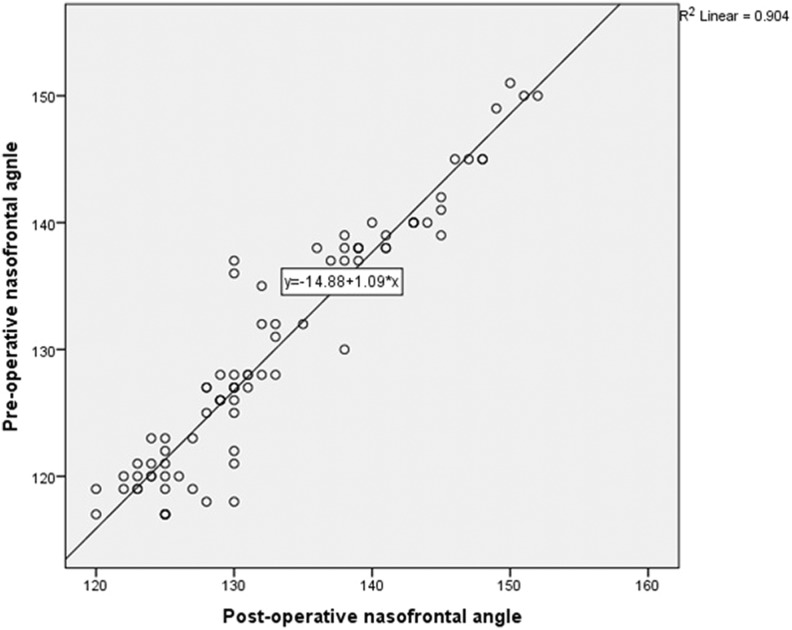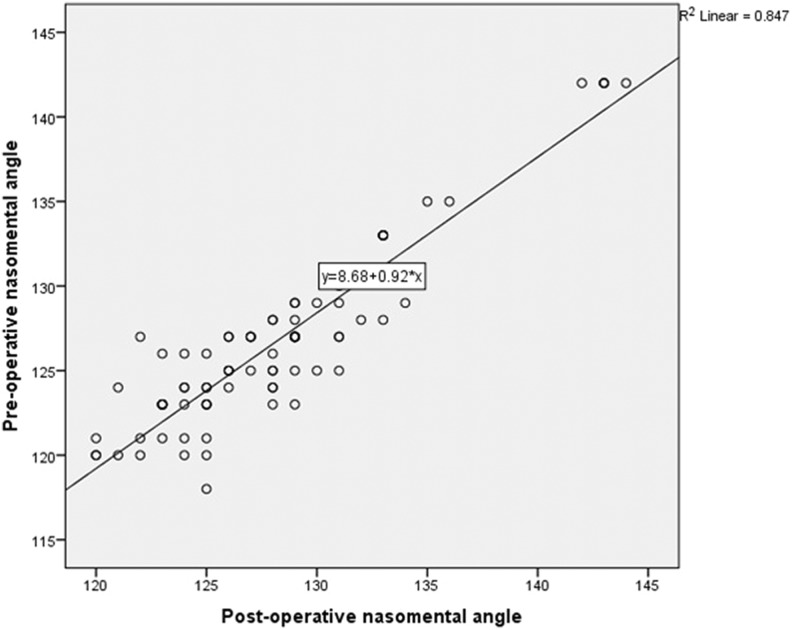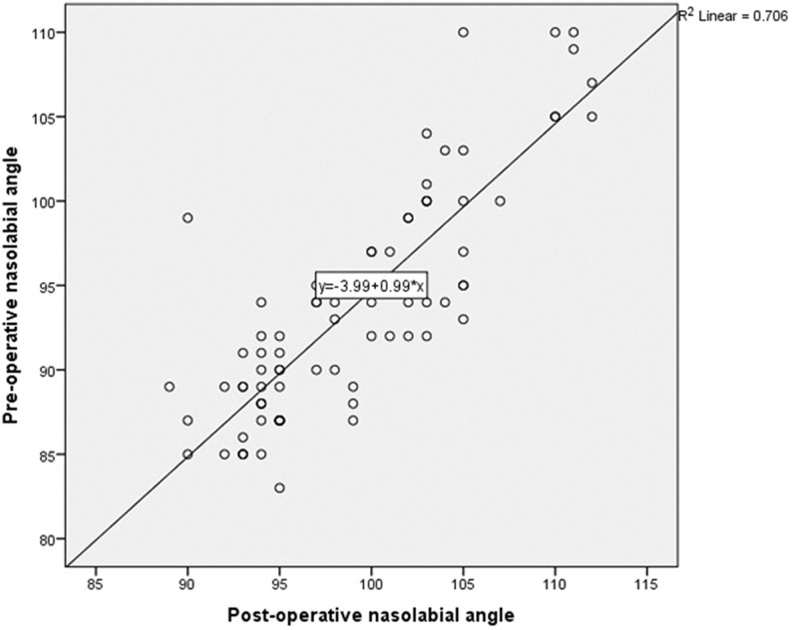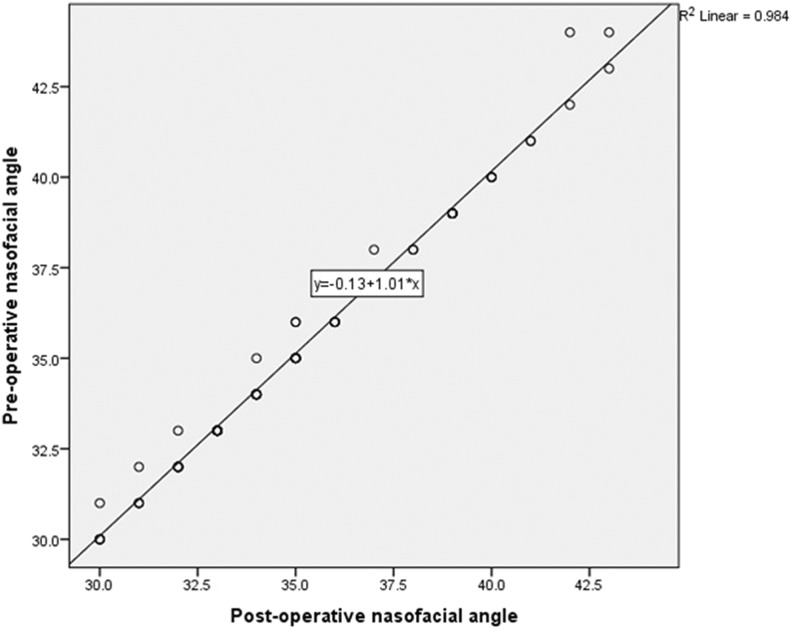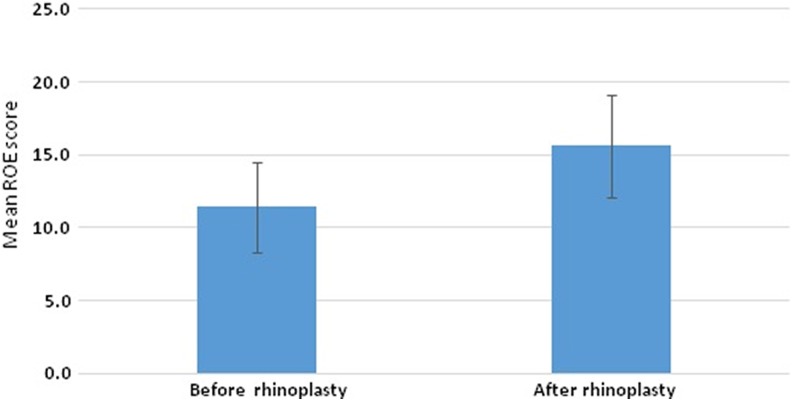Abstract
Hypothesis:
Rhinoplasty is one of the most common aesthetic surgeries. The aim of the study was to evaluate facial proportions and patient satisfaction with the appearance of their nose after rhinoplasty compared to preoperatively.
Methods:
This cross-sectional study was conducted at Islamic Azad University, Mashhad Branch. Eighty-two candidates with indications for primary cosmetic rhinoplasty were selected. Facial proportions and patient satisfaction with their nasal appearance were evaluated before and 6 months after rhinoplasty. Patient satisfaction was assessed using the Rhinoplasty Outcome Evaluation questionnaire.
Results:
Eighty-two patients referred for cosmetic rhinoplasty (13.4% men and 86.6% women) with a mean age of 28.5 (6.4) years underwent open rhinoplasty and were evaluated. Facial proportions, including nasofrontal, nasolabial, and nasomental ratios increased significantly, while the nasofacial ratio, nasal tip projection, columellar show, alar base, and nasal length reduced significantly after rhinoplasty (P < .05). Furthermore, patient satisfaction with the appearance of their nose increased significantly after surgery (P < .001).
Conclusion:
All of the facial proportions changed significantly following rhinoplasty. Although patient satisfaction with nose appearance increases significantly after the operation, there is no significant association between patient satisfaction and facial proportions. As beauty is a subjective, relative and qualitative issue, facial proportions may not be a proper tool to determine facial beauty and predict the satisfaction rate following rhinoplasty.
Keywords: beauty, facial proportion, rhinoplasty
Abstract
Hypothèse:
La rhinoplastie est l’une des chirurgies esthétiques les plus courantes. La présente étude visait à évaluer les proportions faciales et la satisfaction des patients face à l’apparence de leur nez après la rhinoplastie et les comparer à la situation préopératoire.
Méthodologie:
Les chercheurs ont réalisé la présente étude transversale à l’antenne de Mechhed de l’université islamique Azad; ils ont sélectionné 82 candidats à une rhinoplastie esthétique primaire. Ils ont évalué les proportions faciales et la satisfaction des patients face à l’apparence de leur nez avant leur rhinoplastie et six mois après l’intervention. Ils ont évalué la satisfaction des patients à l’aide du questionnaire d’évaluation des résultats de la rhinoplastie.
Résultats:
Les chercheurs ont évalué 82 personnes d’un âge moyen de 28,5±6,4 ans (13,4 % d’hommes et 86,6 % de femmes) qui ont subi une rhinoplastie esthétique ouverte. Leurs proportions faciales, y compris les ratios nez-front, nez-lèvres et nez-menton, ont augmenté sensiblement, alors que le ratio naso-facial, la projection de la pointe nasale, la columelle, la base du cartilage alaire et la longueur du nez ont plutôt diminué nettement après la rhinoplastie (P < .05). La satisfaction des patients envers les résultats de la rhinoplastie s’est également accrue de manière significative après l’opération (P < .001).
Conclusion:
Toutes les proportions faciales ont changé considérablement après la rhinoplastie. Même si la satisfaction des patients a beaucoup augmenté après l’opération, il n’y a pas d’association majeure entre cette satisfaction et les proportions faciales. Comme la beauté est subjective, relative et qualitative, les proportions faciales ne sont peut-être pas un outil convenable pour évaluer la beauté faciale et prédire le taux de satisfaction après une rhinoplastie.
Introduction
Cosmetic plastic surgeries have gained popularity in recent decades, particularly by females, to achieve attractiveness and youth. Rhinoplasty is one of the most common facial cosmetic plastic surgeries and is 1 of the 5 most popular plastic surgery procedures.1 As the nose shape has a significant effect on facial beauty, rhinoplasty has a significant effect on facial beauty. Rhinoplasty can provide safe and effective results in individuals with unfavourable nasal shapes. The recent rhinoplasty guideline published in 2017 has a wealth of insight relevant to the consideration of preoperative planning for rhinoplasty.2 Cosmetic rhinoplasty may improve self-esteem and self-confidence by improving the balance in facial appearance.3
Judgement regarding the outcome of cosmetic rhinoplasty is difficult because it is a qualitative and subjective matter and is judged differently based on the facial characteristics of each person. However, some tools have been developed to evaluate facial beauty and attractiveness quantitatively.4
Facial proportions are numerical indices that estimate ideal facial beauty and attractiveness quantitatively. Facial parameters and proportions include nasofrontal, nasolabial, nasofacial nasomental ratios as well as nasal tip projections and nasal lengths.5-7 Although standard facial parameters and proportions differ according to the various age, race, and gender groups,8 ideal facial proportions have been defined in different races and gender groups (Table 1).9
Table 1.
Ideal Facial Proportions.
| Parameters | Value |
|---|---|
| Nasofrontal | 120-130 in males and 115-125 in females |
| Nasolabial | 90-95 in males and 100-105 in females |
| Nasofacial | 30-40 |
| Nasomental | 120-132 |
| Nasal tip projection | 0.55 of nasal length |
| Nasal length | 0.67 of lower one-third of face |
| Alar Base (cm) | 1 mm wider than the inner canthus |
| Columellar show (mm) | 3-5 |
Reaching or nearing these target values of facial proportions can indicate the success rate in attaining beauty and the attractiveness target.
Patient satisfaction is a subjective and qualitative tool for evaluating rhinoplasty results and can indicate successful outcomes in rhinoplasty to a certain extent.10 However, different factors such as gender, the perception of the patient,11 preoperative nose shape,12 nasal breathing function, and psychology of the patient13 contribute to patient satisfaction and the successful outcome of rhinoplasty. This study aimed to evaluate facial proportions and patient satisfaction with nasal appearance after rhinoplasty, compared these factors with their preoperative status and examined their relationship.
Materials and Methods
This cross-sectional study was conducted at the Mashhad Branch, Islamic Azad University from January 2014 to January 2015. All of the individuals referred to the hospitals affiliated with the Mashhad Branch, Islamic Azad University for primary cosmetic rhinoplasty from 2014 to 2015 were eligible and were selected consecutively. Those with any medical indication for rhinoplasty and patients who were candidates for revision rhinoplasty were excluded from the study.
The ethics committee at the Mashhad branch of Islamic Azad University approved the study protocol, and all patients signed written informed consent before enrolment. Rhinoplasty was carried out by one ear, nose, and throat surgeon. Open rhinoplasty was performed in all of the patients. Patient satisfaction with nasal appearance after rhinoplasty was evaluated by using the Rhinoplasty Outcome Evaluation (ROE) questionnaire (Portuguese-Brazilian).14,15 Rhinoplasty Outcome Evaluation is a questionnaire with 6 questions that is used for assessing patient satisfaction with rhinoplasty results. Each question on the ROE questionnaire is scored from a 0 to 4 and, therefore, the total score varies between 0 and 24. Higher scores indicate greater patient satisfaction with the appearance of the nose after surgery. The reliability of the ROE questionnaire was evaluated by test–retest, and Cronbach alpha was calculated. The ROE questionnaire was completed 6 months after rhinoplasty.
In addition, to evaluate facial beauty, facial proportions and facial ratios were measured on facial photographs obtained before and after 6 months of rhinoplasty. Ideal facial proportions are shown in Table 1.9
Statistical Analysis
Data are presented as the mean and standard deviation for numerical variables and the number and percentage for qualitative variables. The normality of data was examined by the Kolmogorov-Smirnov test with the Lilliefors correction. When the normality of data distribution was confirmed, the independent sample t test was used for the comparison of data. The SPSS software version 22.00 for Windows was used for data analysis, and P values equal to or less than .05 was considered significant.
Results
In this prospective study, 82 individuals who were candidates for primary rhinoplasty were included, and all of them completed the study. The mean age of the participants was 28.5(6.4; 18-47) years, and the greatest portion (60%) of patients were aged between 25 and 40 years. Among the 82 individuals, 11 (13.4%) were male, and 71 (86.6%) were female.
Six months after rhinoplasty, the facial parameters changed significantly. The facial proportions including the nasofacial ratio, nasal tip projection, columellar show, alar base, and nasal length decreased significantly, while the nasofrontal, nasolabial, and nasomental ratios increased significantly after rhinoplasty (P < .05; Table 2).
Table 2.
Facial Proportions in the Study Participants Before and After Rhinoplasty.
| Parameters | Before Rhinoplasty, Mean (SD) | After Rhinoplasty, Mean (SD) | P Value |
|---|---|---|---|
| Nasofrontal | 130 (9.6) | 132.9 (8.4) | <.001 |
| Nasolabial | 93.6 (6.7) | 98.9 (5.7) | <.001 |
| Nasofacial | 35.5 (3.3) | 35.4 (3.2) | .004 |
| Nasomental | 126.6 (5.3) | 128.1 (5.3) | <.001 |
| Nasal tip projection (cm) | 3.3 (0.4) | 3.1 (0.3) | <.001 |
| Nasal length (cm) | 4.9 (0.5) | 4.8 (0.5) | <.001 |
| Alar Base (cm) | 3.4 (0.4) | 3.2 (0.3) | <.001 |
| Columellar show (mm) | 3.3 (1.2) | 3.1 (0.9) | .009 |
Abbreviation: SD, standard deviation.
A mean increase of 2.96° in the nasofrontal ratio (Figure 1), 1.43° in the nasomental ratio (Figure 2), and 5.27° in the nasolabial proportion (Figure 3), and a mean decrease of 1.3° in the nasofacial ratio (Figure 4) were observed 6 months after rhinoplasty. All of these differences between pre- and post-operative measures were statistically significant (P < .05; Table 2).
Figure 1.
Correlation between pre- and post-operative nasofrontal proportion.
Figure 2.
Correlation between pre- and post-rhinoplasty nasomental proportion.
Figure 3.
Correlation between pre- and post-operative nasolabial proportion.
Figure 4.
Correlation between pre- and post-operative nasolabial proportion.
Based on the ROE score, 6 months later rhinoplasty, the patient satisfaction score with their nasal appearance increased from 11.4 (3.1) to 15.6 (3.5; P < .001; Figure 5). The satisfaction with nasal appearance before rhinoplasty in 46.3% of participants was less than the mean12 while after surgery, 85.36% (70 cases) of individuals had an ROE score of greater than the mean. Among them, 9 (10.97%) were highly satisfied with the appearance of the nose (ROE score≥20). After rhinoplasty, satisfaction increased in 61 individuals (74.4%), while it decreased in 10 people (12.2%) and did not change in the others (11 persons/13.4%). There was no significant relationship between the ROE score of the patient 6 months after rhinoplasty and the facial parameters (P > .05; data not shown).
Figure 5.
Patient satisfaction with nose appearance based on ROE score before and after rhinoplasty. ROE indicates Rhinoplasty Outcome Evaluation
Discussion
Rhinoplasty is one of the most popular facial plastic surgeries, especially among females. In this study, most of those referred for rhinoplasty were female and aged between 25 and 40 years. Six months after rhinoplasty, significant changes were observed in the facial parameters and proportions, and their satisfaction with their nasal shape increased as well. However, there was no significant relationship between the satisfaction score and the facial proportions.
Sadeghian et al evaluated the facial aesthetic parameters after rhinoplasty.16 In their study, only the changes in the nasolabial ratio after rhinoplasty was significant, and changes in other proportions were not significant.16 These findings are different from ours in that all changes were significant.
In a similar study by Pasinato et al, all of the differences between the pre- and post-operative measures of facial proportions were significant except for the nasomental ratio.17 These findings are somewhat similar to our study results. The direction of all changes in these ratios was similar to the findings in the Pasinato et al study.17
In a study previously conducted on 84 patients in Iran, 72% of individuals were satisfied or highly satisfied with the result of cosmetic rhinoplasty after an average of 9.4 months from the time of rhinoplasty.18 Most of the previous studies such as ours and the study by Sadeghi Hassanabadi et al have shown improvements in patient satisfaction after rhinoplasty.19,20 The satisfaction rate in our study was relatively similar to the rates in these studies.18-20
In the study by Sadeghi Hassanabadi et al, there were significant associations between patient satisfaction and some of the facial proportions such as the nasofrontal ratios. These associations were not observed in our study.18
In a recent study conducted by Sena Esteves et al, the aesthetic and functional outcome of rhinoplasty were evaluated 3 and 6 months after surgery. In their study, a significant improvement was observed in the satisfaction and quality of life after surgery. In addition, the authors concluded that patients with lower literacy rates were more satisfied with the rhinoplasty results.21 In our study, satisfaction improved significantly after rhinoplasty. However, we did not evaluate the quality of life in our study.
In a study conducted in Brazil on 60 patients who underwent closed rhinoplasty, the satisfaction with the rhinoplasty result was evaluated at least 1 year after rhinoplasty. In this study, 88.3% of patients were completely satisfied with the result of rhinoplasty. In our study, approximately 11% of patients were highly satisfied with the rhinoplasty results, a finding that is different from the study in Brazil. The questionnaire used for evaluating patient satisfaction in that study was the same used in ours, while the type of rhinoplasty was different (closed vs open). The study by de Azambuja Pereira Filho showed a high satisfaction rate with closed rhinoplasty in the long term22 that confirmed the results of the study by Souza Pinto et al.23 They concluded that closed rhinoplasty had good functional and aesthetic outcome in the long term.
Ozturk et al evaluated outcome of rhinoplasty in 50 patients. In their study there was a significant correlation between satisfaction score and nasal breathing.24 In our study, breathing function was not assessed.
To have successful rhinoplasty results, a preoperative assessment of the nose and the nasal airway as well as a consideration of the expectations of the surgery in both the patients and surgeons are essential. In addition to these issues, a consideration of several intra- and post-operative points such as restoring the normal anatomy, correcting of the deformity using incremental control and preserving the nasal airway during surgery as well as during postoperative care and the proper management of complications lead to a successful rhinoplasty outcome.25 Of note, a successful rhinoplasty result may be different from the view of the surgeon and the patient. From the view of the surgeon, obtaining appropriate facial ratios may be considered to be a successful outcome, while from the view of the patient, having good nasal functional outcome as well as achieving optimal nasal and facial aesthetics is considered to be a successful rhinoplasty outcome and thereby increases patient satisfaction. Therefore, there appears to be a significant difference between plastic surgeon and patient preferences.26
As beauty is a relative concept, it may be defined differently in various regions, ethnic groups and cultures, and aesthetic perception may be influenced by these factors in patients and surgeons. There is no common parameter to define ideal nose beauty across various cultures and ethnic backgrounds.26
Computer imaging software is a tool that is used to accurately plan the operation.4 A previous study showed compatible results between computer imaging and patient preference in the Greek population.4 However, the results of different studies in this field are not consistent, because the facial parameters that are used for predicting beauty may not be compatible with patient preference, which is influenced by ethnicity and culture.
Future studies for assessing the relationship between facial proportions and patient satisfaction are suggested when taking racial characteristics of the face into consideration and by applying other satisfaction tools to assess nasal breathing function and the psychology of the patient.
In conclusion, all of the facial proportions change significantly after rhinoplasty, and patient satisfaction increases as well. As the values of facial proportions were in the normal range before rhinoplasty and remained in the normal range after rhinoplasty (after significant changes), interpreting the results is difficult because there was no significant association between facial proportions and the patient satisfaction score.
Although reaching or nearing target facial proportion values indicates a quantitative success in achieving the beauty and attractiveness targets, the qualitative result may be somewhat different. Because beauty is a subjective, relative and qualitative concept, facial proportions may not be a proper tool to determine facial beauty and predict patient satisfaction following rhinoplasty.
Footnotes
Level of Evidence: Level 2, Therapeutic
Authors’ Note: The study was conducted at Islamic Azad University, Mashhad Branch, Mashhad, Iran.
Declaration of Conflicting Interests: The author(s) declared no potential conflicts of interest with respect to the research, authorship, and/or publication of this article.
Funding: The author(s) received no financial support for the research, authorship, and/or publication of this article.
References
- 1. American Society of Plastic Surgeons. Plastic Surgery Statistics Report: American Society of Plastic Surgeons; 2015. https://d2wirczt3b6wjm.cloudfront.net/News/Statistics/2015/plastic-surgery-statistics-full-report-2015.pdf. Accessed December 30, 2016.
- 2. Ishii LE, Tollefson TT, Basura GJ, et al. Clinical practice guideline: improving nasal form and function after rhinoplasty executive summary. Otolaryngol Head Neck Surg. 2017;156(2):205–219. [DOI] [PubMed] [Google Scholar]
- 3. Zamani SN, Fazilatpour M. The effects of cosmetic surgery on patients’ self-esteem and negative image of themselves. J Kerman Uni Med Sci 2013;20:7–10. [Google Scholar]
- 4. Mahajan AY, Shafiei M, Marcus BC. Analysis of patient-determined preoperative computer imaging. Arch Facial Plast Surg. 2009;11(5):290–295. [DOI] [PubMed] [Google Scholar]
- 5. Pallett PM, Link S, Lee K. New “golden” ratios for facial beauty. Vision Res. 2010;50(2):149. [DOI] [PMC free article] [PubMed] [Google Scholar]
- 6. Kalantar Hormozi A, Beiraghi Toosi A. Rhinometry: an important clinical index for evaluation of the nose before and after rhinoplasty. Aesth Plast Surg. 2008;32(2):286–293. [DOI] [PubMed] [Google Scholar]
- 7. Prendergast PM. Facial proportions In: Erian A SMe, ed. Advanced Surgical Facial Rejuvenation. Dublin, Ireland: Springer-Verlag Berlin Heidelberg; 2012. [Google Scholar]
- 8. Larrabee WF, Makielski KH, Henderson JL. Variations in facial anatomy with race, sex, and age In: Larrabee WF MK, Henderson JL, eds. Surgical Anatomy of the Face. Philadelphia, PA: Lippincott Williams & Wilkins; 2004:22–28. [Google Scholar]
- 9. Kalantar-Hormozi A, Beiraghi Toosi A. Rhinometry: an important clinical index for evaluation of the nose before and after rhinoplasty In: Shiffman MA DGA, ed. Advanced Aesthetic Rhinoplasty Art, Science, and New Clinical Techniques. London, England: Springer Heidelberg New York Dordrecht; 2013:119–130. [Google Scholar]
- 10. Guyuron B, Bukhari F. Patient satisfaction following rhinoplasty. Aesth Plast Surg. 1996;20(2):153–157. [DOI] [PubMed] [Google Scholar]
- 11. Moolenburgh SE, Mureau M, Hofer SO. Aesthetic outcome after nasal reconstruction: patient versus panel perception. J Plast Reconstr Aesthet Surg. 2008;61(12):1459–1464. [DOI] [PubMed] [Google Scholar]
- 12. Cingi C, Eskiizmir G. Deviated nose attenuates the degree of patient satisfaction and quality of life in rhinoplasty: a prospective controlled study. Clin Otolaryngol. 2013;38(12):136–141. [DOI] [PubMed] [Google Scholar]
- 13. Davis RE, Bublik M. Psychological considerations in the revision rhinoplasty patient. Facial Plast Surg. 2012;28(4):374–379. [DOI] [PubMed] [Google Scholar]
- 14. Alsarraf R. Outcomes research in facial plastic surgery: a review and new directions. Aesthetic Plastic Surg. 2000;24(3):192–197. [DOI] [PubMed] [Google Scholar]
- 15. Izu SC, Kosugi EM, Lopes AS, et al. Validation of the Rhinoplasty Outcomes Evaluation (ROE) questionnaire adapted to Brazilian Portuguese. Qual Life Res. 2014;23(3):953–958. [DOI] [PubMed] [Google Scholar]
- 16. Sadeghian S, Rasti M, Nazem R. Evaluation of changes in esthetic facial parameters subsequent to rhinoplasty. J Isfahan Dental School. 2011;6(5):553–560. [Google Scholar]
- 17. Pasinato R, Mocellin M, Arantes MC, Coelho MS, Dall’Igna DP, Soccol AT. Pre and post operative facial angles in patients submitted to rhinoplasty. Int Arch Otorhinolaryngol. 2008;12:393–396. [Google Scholar]
- 18. Sadeghi Hassanabadi M, Sadr Hosseini SM, Saedi B. Evaluation of results of rhinoplasty using computerized beauty criteria. J School of Medicine, Tehran University Med Sci. 2004;62:481–489. [Google Scholar]
- 19. Deepalakshmi T, Gururaj T, Sushant K, Devan PP, Rukma B. Assessment of surgical outcomes of rhinoplasty: a clinical study. Online J Otolaryngol. 2015;5(4):96–102. [Google Scholar]
- 20. Faidiga GB, Carenzi LR, Yassuda CC, et al. Long-term evaluation in aesthetic rhinoplasty in an academic referral center. Braz J Otorhinolaryngol. 2010;76(4):437–441. [DOI] [PMC free article] [PubMed] [Google Scholar]
- 21. Sena Esteves S, Gonçalves Ferreira M, Carvalho Almeida J, Abrunhosa J, Almeida E Sousa C. Evaluation of esthetic and functional in outcomes rhinoplasty surgery: a prospective study. Braz J Otorhinolaryngol. 2017;83(5):552–557. [DOI] [PMC free article] [PubMed] [Google Scholar]
- 22. de Azambuja Pereira Filho G, Valiati AA, Schilling Minuzzi AC, et al. Assessment of long-term patient satisfaction after rhinoplasty performed at the Plastic Surgery Department of Santa Casa de Misericórdia de Porto Alegre. Rev Bras Cir Plást. 2011;26:618–623. [Google Scholar]
- 23. Souza Pinto EB, Maloof RG, Dutra RT, et al. Rinoplastia endonasal: um estudo do grau de satisfação dos pacientes em cinco anos. Rev Bras Cir Plast. 2010;25:637–640. [Google Scholar]
- 24. Ozturk K GS, Karahan C, Midilli R. Assessing the rhinoplasty outcome: inter-rater variability of aesthetic perception in the light of objective facial analysis. Eur Arch Otorhinolaryngol. 2015;272(12):3709–3713. [DOI] [PubMed] [Google Scholar]
- 25. Rohrich RJ, Ahmad J. Rhinoplasty. Plast Reconstruc Surg. 2011;128(2):49e–73e. [DOI] [PubMed] [Google Scholar]
- 26. Broer PN, Buonocore S, Morillas A, et al. Nasal aesthetics: a cross-cultural analysis. Plast Rreconstruc Surg. 2012;130(6):843e–850e. [DOI] [PubMed] [Google Scholar]



